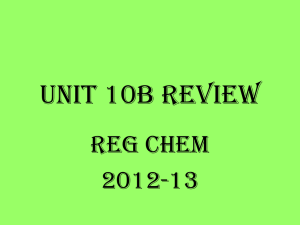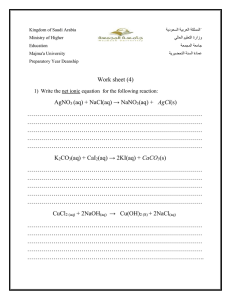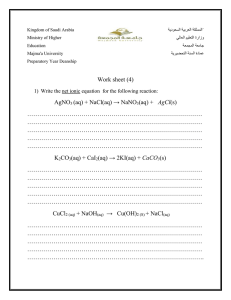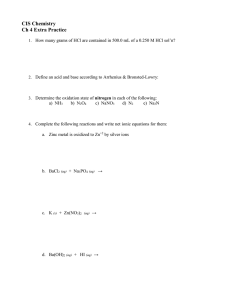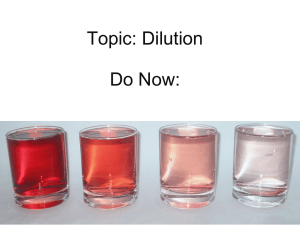solutions PPT
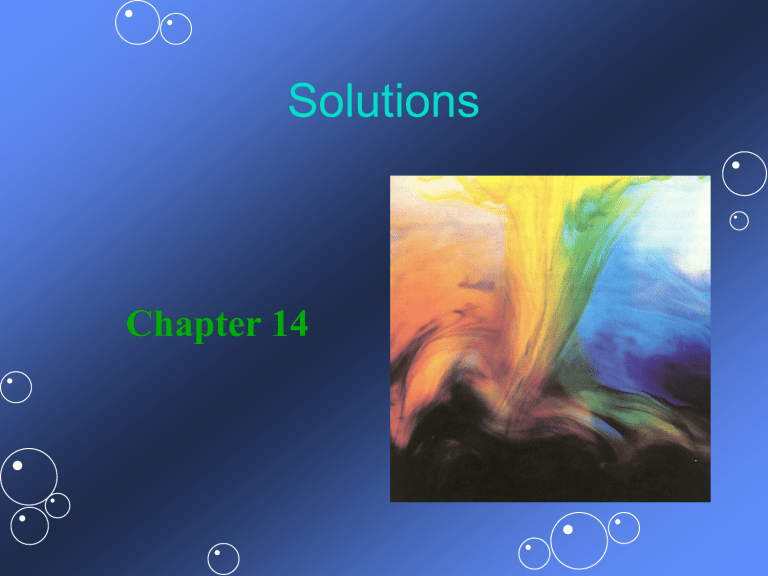
Solutions
Chapter 14
Common Solutions
Chemical solutions encountered in everyday life: air coffee tap water shampoo orange soda gasoline cough syrup
Gatorade
Solutions
. . . the components of a mixture are uniformly intermingled
(the mixture is homogeneous ).
A Solute
dissolves in water (or other “solvent”)
changes phase (if different from the solvent)
is present in lesser amount (if the same phase as the solvent)
A Solvent
retains its phase (if different from the solute)
is present in greater amount (if the same phase as the solute)
Figure 14.1: When solid sodium chloride dissolves, the ions are dispersed randomly throughout the solution
Aqueous Solutions
Aqueous solutions are solutions in which water is the solvent.
Aqueous solutions are the most common type of solution.
Some Properties of Water
Water is able to dissolve so many substances because:
-
Water is “bent” or
V-shaped .
The O-H bonds are covalent .
Water is a polar molecule.
Hydration occurs when salts dissolve in water.
04_40
H
2
O
105
H
Water is a polar molecule because it is a bent molecule. The hydrogen end is
+ while the oxygen end is
, Delta (
) is a partial charge--less than 1.
04_41
+
H
O H
+
+
+
+
+
+
H
O
Cation
+
+
+
+
+
+
Anion
Polar water molecules interact with the positive and negative ions of a salt, assisting in the dissolving process. This process is called hydration .
Solubility
The general rule for solubility is:
“Like dissolves like.”
Polar water molecules can dissolve other polar molecules such as alcohol and, also, ionic substances such as NaCl.
Nonpolar molecules can dissolve other nonpolar molecules but not polar or ionic substances. Gasoline can dissolve grease.
Miscibility
Miscible -- two substances that will mix together in any proportion to make a solution. Alcohol and water are miscible because they are both polar and form hydrogen bonds.
Immiscible -- two substances that will not dissolve in each other. Oil and vinegar are immiscible because oil is nonpolar and vinegar is polar.
Figure 14.6: An oil layer floating on water
Structure & Solubility
Like dissolves like.
Hydrophobic --water-fearing. Fat soluble vitamins such as A, D, E, & K.
Hydrophilic --water-loving. Water soluble vitamins such as B & C.
Hypervitaminosis--excessive buildup of vitamins A, D, E, & K in the body.
Solubility
How does the rule “Like dissolves like.” apply to cleaning paint brushes used for latex paint as opposed to those used with oil-based paint?
Common Terms of Solution
Concentration
Saturated - when a solution contains as much solute as will dissolve at that temperature.
Unsaturated - when a solution has not reached its limit of solubility.
Supersaturated - when a solution has more of the solute dissolved than it normally would -very unstable.
Common Terms of Solution
Concentration
Stock - routinely used solutions prepared in concentrated form.
Concentrated relatively large ratio of solute to solvent. ( 5.0 M NaCl )
Dilute relatively small ratio of solute to solvent. ( 0.01 M NaCl )
Solution Composition
Qualitative -- general and relative.
Quantitative -- mathematically defined.
dilute
Mass % -- biology concentrated
Molarity -- most solutions in chemistry
Normality -- chemical titrations
Molality -- molar mass, freezing point depressions, & boiling point elevations
Mass %
Mass (weight) percent = mass of solute mass of solution
( 100%)
Mass % Calculations
If 1.00 g of ethanol is added to 100.0 g of water, what is the mass % of the ethanol?
% C
2
H
5
OH
massethano l masssoluti on
1 .
00
101 .
0 g g
100 %
0 .
990 % C
2
H
5
OH
100 %
Mass % Calculations
Cow’s milk typically contains 4.5 % by mass of the sugar lactose, C
12
H
22
O
11
. Calculate the mass of lactose present in 175 g of milk.
Mass % = mass of solute mass of solution
( 100%) mass of solute = (mass %)(mass of solution)/(100%) mass of solute = (4.5 % lactose)(175 g)/(100%) mass of solute = 7.9 g lactose
Molarity
Molarity ( M ) = moles of solute per volume of solution in liters:
M
molarity moles of solute liters of solution
3
M
HCl
6 moles of HCl
2 liters of solution
Molarity Calculations
If 1.00 g of ethanol is dissolved in enough water to make 101 mL of solution, what is the molarity of the solution?
1 .
00 gethanol
101 mL
1000 mL
1 L
1 mol
46 .
07 g
0 .
215 M
Molarity Calculations
Calculate the molarity of a solution prepared by dissolving 11.5 g of solid NaOH in enough water to make 1.50 L of solution.
(11.5g NaOH/1.50L)(1 mol NaOH/40.00g NaOH)
= 0.192 M NaOH
Molarity Calculations
Calculate the molarity of a solution prepared by dissolving 1.56 g of gaseous HCl into enough water to make 26.8 mL of solution.
(1.56g HCl/26.8mL)(1mol/36.5g)(1000mL/1L) =
1.59 M HCl solution
Molarity Calculations
How many moles of nitrate ions are present in
25.00 mL of a 0.75 M Co(NO
3
)
2 solution?
(25.00mL)(1L/1000mL)(0.75mol Co(NO
3
)
2
/1L)
(2 mol NO
3
/1 mol Co(NO
3
)
2
) = 3.8 x 10 -2 mol NO
3
-
Molarity Calculations
Typical blood serum is about 0.14M NaCl. What volume of blood contains 1.0 mg of NaCl?
(1.0mg NaCl)(1g/1000mg)(1mol/58.45g)(1L/0.14mol)
= 1.2 x 10 -4 L blood serum
Molarity Calculations
A chemist needs 1.00 L of an aqueous 0.200 M
K
2
Cr
2
O
7 solution. How much solid potassium dichromate must be massed to make this solution?
(1.00L)(0.200mol K
2
Cr
2
O
7
/L)(294.2g/1mol) =
58.8 g K
2
Cr
2
O
7
Standard Solution
A standard solution is a solution whose concentration is accurately known.
A volumetric flask is used to make a standard solution.
04_44
Volume marker
(calibration mark)
Weighed amount of solute
Wash Bottle
(a) (b) (c) (d)
Steps involved in making a standard solution.
Dilution of Stock Solutions
When diluting stock solutions, the moles of solute after dilution must equal the moles of solute before dilution .
moles of solute before dilution = moles of solute after dilution
Stock solutions are diluted using either a measuring or a delivery pipet and a volumetric flask.
04_46
Rubber bulb
500 mL
(a) (b)
Steps to dilute a stock solution.
(c)
Dilution Calculations
What volume of 16 M sulfuric acid must be used to prepare 1.5 L of a 0.10 M H
2
SO
4 solution?
(0.10mol H
2
SO
4
/1L)(1.5L)(1L/16mol)(1000mL/1L)
= 9.4 mL conc H
2
SO
4
Dilution Calculations
What volume of 12 M HCl must be taken to prepare 0.75 L of 0.25 M HCl?
(0.75L)(0.25mol HCl/L)(1L/12mol)(1000mL/1L)
= 16 mL conc. HCl
Steps For Solving Solution
Stoichiometry Problems
1. Write the balanced reaction.
2. Calculate moles of reactants.
3. Determine limiting reactant.
4. Calculate moles of required reactant/product.
5. Convert to grams or volume, as required.
Precipitation Calculations
When aqueous solutions of Na
2
SO
4
& Pb(NO
3
)
2 when 1.25 L of 0.0500 M Pb(NO
Na
2
SO
4 are mixed.
3
)
2 are mixed,
PbSO
4 precipitates. Calculate the mass of PbSO
4 formed
& 2.00 L of 0.0250 M
1. Pb(NO
3
)
2(aq)
+ Na
2
SO
4(aq)
----> PbSO
4(s)
+ 2NaNO
3(aq)
2. (1.25L)(0.0500mol Pb(NO
3
)
2
/L) = 0.0625 mol Pb(NO
3
)
2
(2.00L)(0.0250mol Na
2
SO
4
/L) = 0.0500 mol Na
2
SO
4
Precipitation Calculations
Continued
3. (0.0625mol Pb(NO
3
)
2
)(1mol Na
2
SO
4
/1mol Pb(NO
3
)
2
=
0.0625 mol Na
2
SO
4
Na
2
SO
4 is the limiting reactant.
4. (0.0500mol Na
2
SO
4
)(1mol PbSO
4
/1mol Na
2
SO
4
)
(303.3g/1mol) = 15.2 g PbSO
4
Neutralization Reactions
Acids and bases react to neutralize each other and form a salt and water. This type of reaction is called a neutralization reaction.
HCl
(aq)
+ NaOH
(aq)
----> NaCl
(aq)
+ HOH
(l)
Acid-Base Calculations
What volume of a 0.100 M HCl solution is needed to neutralize 25.0 mL of 0.350 M NaOH?
HCl
(aq)
+ NaOH
(aq)
----> HOH
(l)
+ NaCl
(aq)
(25.0mL)(0.350mol NaOH/1L)(1mol HCl/1mol
NaOH)(1L/0.100mol) = 87.5 mL HCl solution
Normality
Normality ( N )
equivalent ssolute
Litersolut ion
Acid-Base Equivalents = (moles) (total (+) charge)
N = M ( total (+) charge)
Normality Calculations
.250 M H
3
PO
4
=______N
N = M(total(+) charge)
N = (0.250)(3)
N = 0.750 N H
3
PO
4
Normality Calculations
A solution of sulfuric acid contains 86 g of H
2
SO
4 per liter of solution. What is its normality?
(86g H
2
SO
4
/1L)(1mol/98.0g) = 0.88 M H
2
SO
4
N = M(total (+) charge)
N = (0.88M)(2)
N = 1.8 N H
2
SO
4
Normality Stoichiometry
Calculations
What volume of a 0.075 N NaOH solution is required to react exactly with 0.135 L of 0.45 N
H
3
PO
4
?
N a
V a
= N b
V b
N a
= 0.45 N
V b
= (N a
V a
)/N b
V a
= 0.135 L
V b
= (0.45N)(0.135L)/(0.075N)
N b
= 0.075 N
V b
= 0.81 L NaOH
V b
= ?
